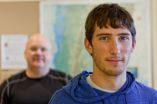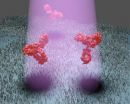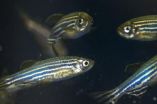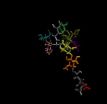(Press-News.org) Glaucoma, a leading cause of irreversible blindness, is associated with elevated pressure in the eye. This elevated pressure essentially is due to a plumbing problem. Fluid builds up in the eye, increasing pressure and eventually damaging the optic nerve. For nearly 150 years, researchers have been trying to understand what causes the blockage that prevents the eye from draining properly.
In a unique study of human ocular cells, a multi-institution research team led by a biomedical engineer at Northwestern University has found a new culprit. Glaucoma appears to be a consequence of mechanical dysfunction of endothelial cells -- a thin layer of cells that is the final barrier to fluid entering Schlemm's canal, from which fluid then drains from the eye.
The researchers found that these endothelial cells from eyes with glaucoma are stiffer than cells from healthy eyes. This stiffness limits the cells' ability to deform and allow a fluid called aqueous humor to cross the endothelium and drain into Schlemm's canal. This increased flow resistance is responsible for the elevated pressure associated with glaucoma.
The findings were published this week in the online early edition of the journal Proceedings of the National Academy of Sciences (PNAS).
"There is no cure for glaucoma, which affects more than two million Americans," said Mark Johnson, the senior author of the study. "Our work shows that cells of this endothelial layer act as mechanical gates. Therapeutic strategies that alter the stiffness of these cells potentially could lead to a cure for this debilitating disease."
Johnson is a professor of biomedical engineering and mechanical engineering at Northwestern's McCormick School of Engineering and Applied Science and a professor of ophthalmology at Northwestern University Feinberg School of Medicine.
Both Schlemm's canal and the clear aqueous humor it drains from the eyeball are vital to the eye's health and function. The aqueous humor nourishes the eye and maintains its proper pressure. Aqueous humor from the eye's anterior chamber (located between the iris and cornea) collects in the canal from which it then flows into the vascular system. If the endothelial cells lining Schlemm's canal are too stiff, it is difficult for them to form pores that allow the aqueous humor to pass through this thin layer and drain into the canal. Pressure then increases in the eye and eventually causes damage to the optic nerve at the back of the eye.
"The work appears to be one of the first times that the methods of mechanobiology -- the study of the mechanical characteristics of cells -- have been used to show that dysfunctional cell mechanics lies at the heart of a disease process," Johnson said.
INFORMATION:
The title of the paper is "Altered mechanobiology of Schlemm's canal endothelial cells in glaucoma." Johnson's co-authors on the study are from Imperial College London, the Harvard School of Public Health, Duke University, the Universität Regensburg in Germany, Georgia Institute of Technology and Emory University.
New glaucoma culprit is found
Gatekeeper cells are stiffer in human eyes with glaucoma, increasing pressure
2014-09-15
ELSE PRESS RELEASES FROM THIS DATE:
Getting hot and wet in Vermont
2014-09-15
Here's your northern Vermont forecast for the rest of this century: annual precipitation will increase by between a third and half an inch per decade, while average temperatures will rise some five degrees Fahrenheit by midcentury. By late in the century, average temperatures will have spiked more than eight degrees. In July, by 2100, the City of Burlington will have at least ten additional days above ninety degrees. The growing season picks up 43 more days. Looking at ski conditions, expect annual snowfall at six major ski resorts to decline about fifty percent by century's ...
Mayo finds many liver transplant patients can avoid costly stay in ICU after surgery
2014-09-15
JACKSONVILLE, Fla., Sept. 12, 2014 — The liver transplant team at Mayo Clinic in Florida has found, based on 12 years of experience, that more than half of patients receiving a new liver can be "fast-tracked" to return to a surgical ward room following their transplant, bypassing a one- or two-day stay in the Intensive Care Unit (ICU).
In the September issue of the American Journal of Transplantation, the physicians and researchers have turned their knowledge of who can be safely fast-tracked into a scoring system that other transplant centers can also use — thus sparing ...
The shadow of a disease
2014-09-15
This news release is available in German.
In future, some diseases might be diagnosed earlier and treated more effectively. Researchers at the Max Planck Institute for the Science of Light in Erlangen have developed an optical method that makes individual proteins, such as the proteins characteristic of some cancers, visible. Other methods that achieve this only work if the target biomolecules have first been labelled with fluorescent tags; In general, however, that approach is difficult or even impossible. By contrast, with their method, coined iSCAT, the researchers ...
Unemployment for doctoral scientists and engineers below national average in 2013
2014-09-15
A new National Science Foundation (NSF) report says the 2013 unemployment rate for individuals with research doctoral degrees in science, engineering and health (SEH) fields was one-third the rate for the general population aged 25 and older--2.1 percent versus 6.3 percent.
According to the report, an estimated 837,900 individuals in the United States held SEH research doctoral degrees in 2013, and nearly 735,900 of them were in the labor force; this includes those employed full time or part time and unemployed individuals actively seeking work.
Statistics show that ...
USC researchers discover the healing power of 'rib-tickling'
2014-09-15
Unlike salamanders, mammals can't regenerate lost limbs, but they can repair large sections of their ribs.
In a new study in the Journal of Bone and Mineral Research, a team directed by USC Stem Cell researcher Francesca Mariani takes a closer look at rib regeneration in both humans and mice.
The first author of the paper, USC medical student Marissa K. Srour, was a USC undergraduate when she started the project, which earned a 2011 USC Discovery Scholar Prize. Each year, 10 graduating seniors win these coveted prizes, which recognize exceptional new scholarship.
Using ...
Zebrafish model of a learning and memory disorder shows better treatment
2014-09-15
PHILADELPHIA — Using a zebrafish model of a human genetic disease called neurofibromatosis (NF1), a team from the Perelman School of Medicine at the University of Pennsylvania has found that the learning and memory components of the disorder are distinct features that will likely need different treatment approaches. They published their results this month in Cell Reports.
NF1 is one of the most common inherited neurological disorders, affecting about one in 3,000 people. It is characterized by tumors, attention deficits, and learning problems. Most people with NF1 have ...
Advancing the science for health programming in crisis conditions
2014-09-15
September 12, 2014 -- Humanitarian crises are becoming increasingly complex and a growing threat to the health and safety of populations. An improved evidence-base to guide interventions in the countries most vulnerable to these conditions is more critical than ever. A paper by researchers at Columbia University's Mailman School of Public Health published online in the journal Science, looks at the challenges of doing research in such settings and the strategies that must be adopted for scientific advance.
"The circumstances of humanitarian crises present many barriers ...
Decoding 'sweet codes' that determine protein fates
2014-09-15
VIDEO:
Here are movies of dynamic behavior of a sugar chain on the basis of NMR-validated simulations. This chain has a particular sugar (green circle).
Click here for more information.
We often experience difficulties in identifying the accurate shape of dynamic and fluctuating objects. This is especially the case in the nanoscale world of biomolecules. The research group lead by Professor Koichi Kato of the Institute for Molecular Science, National Institutes of Natural Sciences ...
You don't walk alone
2014-09-15
65 million people around the world today suffer from epilepsy, a condition of the brain that may trigger an uncontrollable seizure at any time, often for no known reason. A seizure is a disruption of the electrical communication between neurons, and someone is said to have epilepsy if they experience two or more unprovoked seizures separated by at least 24 hours.
Epilepsy is the most common chronic disease in pediatric neurology, with about 0.5% of children developing epilepsy during their lifetime. A further 30% of epileptic children develop refractory ...
Walking or cycling to work improves wellbeing, University of East Anglia researchers find
2014-09-15
Walking or cycling to work is better for people's mental health than driving to work, according to new research by health economists at the University of East Anglia and the Centre for Diet and Activity Research (CEDAR).
A report published today reveals that people who stopped driving and started walking or cycling to work benefited from improved wellbeing. In particular, active commuters felt better able to concentrate and were less under strain than if they travelled by car.
These benefits come on top of the physical health benefits of walking and cycling that are ...
LAST 30 PRESS RELEASES:
An ‘illuminating’ design sheds light on cholesterol
Who is more likely to get long COVID?
Study showcases resilience and rapid growth of “living rocks”
Naval Research Lab diver earns Office of Naval Research 2025 Sailor of the Year
New Mayo-led study establishes practical definition for rapidly progressive dementia
Fossil fuel industry’s “climate false solutions” reinforce its power and aggravate environmental injustice
Researchers reveal bias in a widely used measure of algorithm performance
Alcohol causes cancer. A study from IOCB Prague confirms damage to DNA and shows how cells defend against it
Hidden viruses in wastewater treatment may shape public health risks, study finds
Unlock the power of nature: how biomass can transform climate mitigation
Biochar reshapes hidden soil microbes that capture carbon dioxide in farmland
Reducing saturated fat intake shows mortality benefit, but only in high-risk individuals
Manta rays create mobile ecosystems, study finds
Study: Mixed results in using lipoic acid to treat progressive multiple sclerosis
Norbert Holtkamp appointed director of Fermi National Accelerator Laboratory
New agentic AI platform accelerates advanced optics design
Biologists discover neurons use physical signals — not electricity — to stabilize communication
Researchers discover that a hormone can access the brain by hitchhiking
University of Oklahoma researcher awarded funding to pursue AI-powered material design
Exploring how the visual system recovers following injury
Support for parents with infants at pediatric check-ups leads to better reading and math skills in elementary school
Kids’ behavioral health is a growing share of family health costs
Day & night: Cancer disrupts the brain’s natural rhythm
COVID-19 vaccination significantly reduces risk to pregnant women and baby
The role of vaccination in maternal and perinatal outcomes associated with COVID-19 in pregnancy
Mayo Clinic smartwatch system helps parents shorten and defuse children's severe tantrums early
Behavioral health spending spikes to 40% of all children’s health expenditures, nearly doubling in a decade
Digital cognitive behavioral treatment for generalized anxiety disorder
Expenditures for pediatric behavioral health care over time and estimated family financial burden
Air conditioning in nursing homes and mortality during extreme heat
[Press-News.org] New glaucoma culprit is foundGatekeeper cells are stiffer in human eyes with glaucoma, increasing pressure




